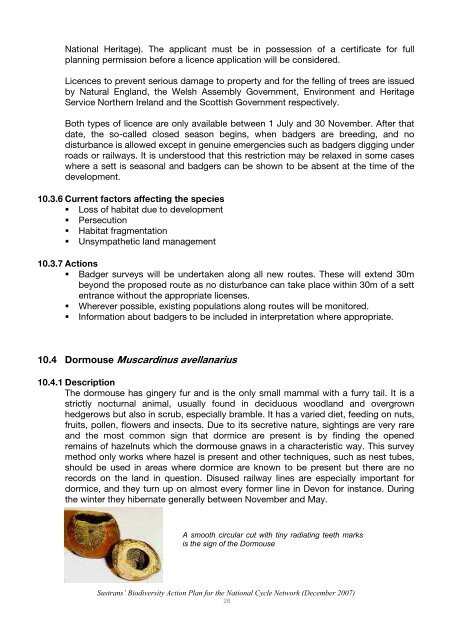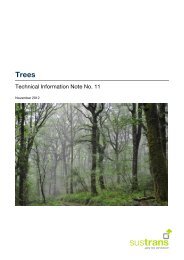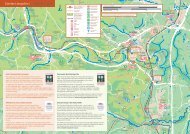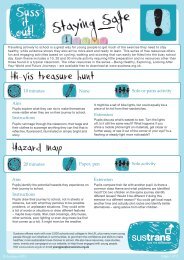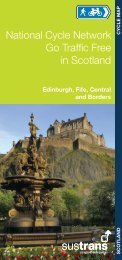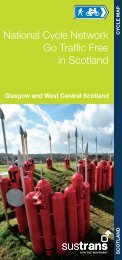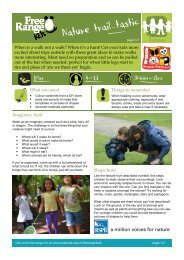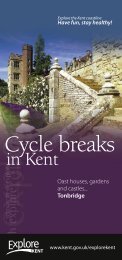Biodiversity Action Plan for the National Cycle Network ... - Sustrans
Biodiversity Action Plan for the National Cycle Network ... - Sustrans
Biodiversity Action Plan for the National Cycle Network ... - Sustrans
You also want an ePaper? Increase the reach of your titles
YUMPU automatically turns print PDFs into web optimized ePapers that Google loves.
<strong>National</strong> Heritage). The applicant must be in possession of a certificate <strong>for</strong> full<br />
planning permission be<strong>for</strong>e a licence application will be considered.<br />
Licences to prevent serious damage to property and <strong>for</strong> <strong>the</strong> felling of trees are issued<br />
by Natural England, <strong>the</strong> Welsh Assembly Government, Environment and Heritage<br />
Service Nor<strong>the</strong>rn Ireland and <strong>the</strong> Scottish Government respectively.<br />
Both types of licence are only available between 1 July and 30 November. After that<br />
date, <strong>the</strong> so-called closed season begins, when badgers are breeding, and no<br />
disturbance is allowed except in genuine emergencies such as badgers digging under<br />
roads or railways. It is understood that this restriction may be relaxed in some cases<br />
where a sett is seasonal and badgers can be shown to be absent at <strong>the</strong> time of <strong>the</strong><br />
development.<br />
10.3.6 Current factors affecting <strong>the</strong> species<br />
Loss of habitat due to development<br />
Persecution<br />
Habitat fragmentation<br />
Unsympa<strong>the</strong>tic land management<br />
10.3.7 <strong>Action</strong>s<br />
Badger surveys will be undertaken along all new routes. These will extend 30m<br />
beyond <strong>the</strong> proposed route as no disturbance can take place within 30m of a sett<br />
entrance without <strong>the</strong> appropriate licenses.<br />
Wherever possible, existing populations along routes will be monitored.<br />
In<strong>for</strong>mation about badgers to be included in interpretation where appropriate.<br />
10.4 Dormouse Muscardinus avellanarius<br />
10.4.1 Description<br />
The dormouse has gingery fur and is <strong>the</strong> only small mammal with a furry tail. It is a<br />
strictly nocturnal animal, usually found in deciduous woodland and overgrown<br />
hedgerows but also in scrub, especially bramble. It has a varied diet, feeding on nuts,<br />
fruits, pollen, flowers and insects. Due to its secretive nature, sightings are very rare<br />
and <strong>the</strong> most common sign that dormice are present is by finding <strong>the</strong> opened<br />
remains of hazelnuts which <strong>the</strong> dormouse gnaws in a characteristic way. This survey<br />
method only works where hazel is present and o<strong>the</strong>r techniques, such as nest tubes,<br />
should be used in areas where dormice are known to be present but <strong>the</strong>re are no<br />
records on <strong>the</strong> land in question. Disused railway lines are especially important <strong>for</strong><br />
dormice, and <strong>the</strong>y turn up on almost every <strong>for</strong>mer line in Devon <strong>for</strong> instance. During<br />
<strong>the</strong> winter <strong>the</strong>y hibernate generally between November and May.<br />
A smooth circular cut with tiny radiating teeth marks<br />
is <strong>the</strong> sign of <strong>the</strong> Dormouse<br />
<strong>Sustrans</strong>’ <strong>Biodiversity</strong> <strong>Action</strong> <strong>Plan</strong> <strong>for</strong> <strong>the</strong> <strong>National</strong> <strong>Cycle</strong> <strong>Network</strong> (December 2007)<br />
28


